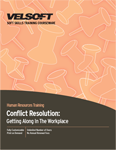Course outline for
Conflict Resolution: Getting Along In The Workplace
Conflict Resolution: Getting Along In The Workplace Course Outline

How to Use This Guide
Session One: Course Overview
Session Two: Defining Conflict
What is Conflict?
Positives and Negatives
Session Three: Types of Conflict
Session Four: Open Conflict vs. Hidden Conflict
Session Five: Spontaneous and Reflective Behavior
Session Six: The Johari Window
Understanding the Johari Window
My Window
Case Study: Spontaneous and Reflective Behaviors
Session Seven: Stages of Conflict
The Five Stages of Conflict
Another Version of the Conflict Process
Conflict Outcomes
Strategies for Dealing with Conflict
Session Eight: Creating the Win/Win
Session Nine: Conflict Resolution Style Questionnaire
The Questionnaire
Scoring
The Conflict Grid
Pros and Cons
Session Ten: The Role of Communication in Conflict Resolution
The Communication Chain
Other Barriers
Establishing Positive Intent
Session Eleven: Active Listening Skills
Session Twelve: Paraphrasing Skills
What is Paraphrasing?
Making Connections
Session Thirteen: Powerful Questions
Asking Questions
Probing Techniques
Session Fourteen: Body Language
Session Fifteen: Pre-Assignment Review
Session Sixteen: The Conflict/Opportunity Test
The Conflict/Opportunity Test
Skills Test
Session Seventeen: Conflict and Its Resolution
Visualizing Conflict
A Strategy for Conflict Resolution
Session Eighteen: Helping Others Through Conflict
Preparing for Conflict
Conflict Resolution with Facilitation
Setting Norms
Coaching Through Conflict
Managing Your Emotions
Recommended Reading List
Post-Course Assessment
Pre- and Post-Assessment Answer Keys
Personal Action Plan
Download this course as a demo
Complete the form below and we'll email you an evaluation copy of this course:
Video
More Course Outlines in this Series
- Understanding and Coping with the COVID-19 Pandemic
- Anger Management: Understanding Anger
- Building Better Teams
- Business Succession Planning: Developing and Maintaining a Succession Plan
- Conducting Effective Performance Reviews
- Conflict Resolution: Getting Along In The Workplace
- Creating a Top-Notch Talent Management Program
- Managing Customer Service
- Closing the Generation Gap in the Workplace
- Employee Dispute Resolution: Mediation through Peer Review
- Hiring for Success: Behavioral Interviewing Techniques
- Onboarding: The Essential Rules for a Successful Onboarding Program
- Orientation Handbook: Getting Employees Off to a Good Start
- Performance Management: Managing Employee Performance
- Stress Management
- Public Relations Boot Camp
- Appreciative Inquiry
- Transgender Employees: Creating an Inclusive Work Community
- Employee Recognition: Appreciating Your Workforce
- Cannabis and the Workplace
- Creativity in the Workplace
- Problem Solving and Decision Making
- Accounting Skills for the New Supervisor
- Change Management: Change and How to Deal With It
- Diversity, Equity, and Inclusion
- Unconscious Bias
